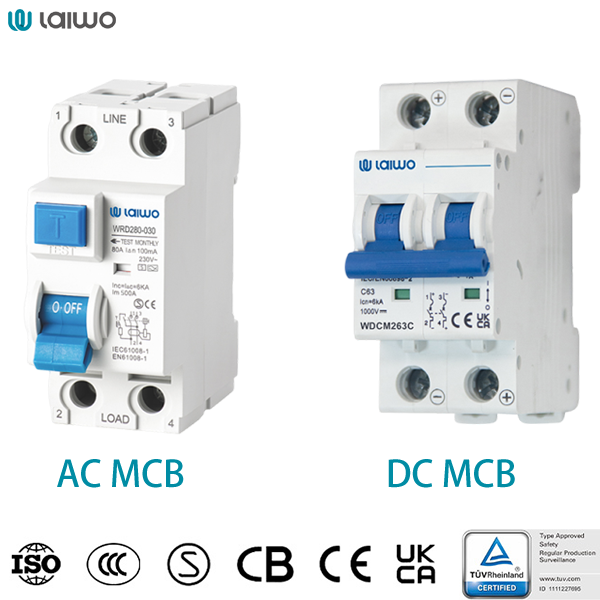Next: Top 10 Reasons and Solutions for Frequent Tripping of MCBs

In the modern world, where solar energy and DC-based systems are booming, a common question arises: “Can AC MCB be used for DC?” While it might seem cost-effective to repurpose AC-rated circuit breakers, doing so poses serious safety risks. This guide dives into the technical differences between AC vs DC MCB, explains why mixing them is dangerous, and recommends reliable DC breaker solutions for industrial and residential setups.

| Feature | AC MCB | DC MCB |
|---|---|---|
| Arc Suppression | Relies on natural current zero-crossing | Uses magnetic blowouts or splitter plates |
| Voltage Rating | 230V–440V (single/three-phase) | 12V–1500V (common for solar/batteries) |
| Applications | Homes, offices, HVAC systems | Solar farms, EV chargers, telecom towers |
| Certification | IEC 60898-1 | IEC 60947-2 |
| Cost | Lower | 20–30% higher due to specialized design |
1. Current Type and Flow Direction
AC MCBs are designed for alternating current, where the current reverses direction periodically (50 or 60 times per second).
DC MCBs handle direct current, which flows continuously in one direction without zero-crossing points.
2. Arc Extinguishing Mechanism
AC MCBs benefit from the natural zero-crossing of AC current, making arc extinction easier and requiring simpler arc chutes.
DC MCBs face a continuous arc due to steady current flow, needing more robust arc suppression like magnetic blowout coils or longer arc chambers to safely interrupt the circuit.
3. Contact Design and Durability
AC MCB contacts are less robust because the arc is less severe and extinguishes quickly.
DC MCB contacts are more durable and made from materials that withstand higher temperatures and prolonged arcs, ensuring reliable interruption.
4. Voltage Ratings
AC MCBs are typically rated for standard residential and commercial AC voltages (110V to 240V or higher).
DC MCBs cover a wider voltage range, from low voltages (12V, 24V) up to high voltages (600V or more), suitable for solar, battery, and EV applications.
5. Polarity Sensitivity
AC MCBs are not polarity sensitive and can be installed without concern for current direction.
DC MCBs are polarity sensitive due to unidirectional current and are marked with "+" and "–" symbols to ensure correct installation.
6. Application Environments
AC MCBs are common in homes, offices, and general industrial settings where AC power is used.
DC MCBs are essential in solar power systems, electric vehicles, battery storage, and other DC-powered industrial equipment.
Learn More:
MCB Types Fully Explained: A Guide to Choosing from Type A to Type D
Alternating Current (AC)
Definition: Current that periodically reverses direction (e.g., household power grids).
Characteristics: Smooth voltage transitions, minimal arcing during interruption.
Direct Current (DC)
Definition: Unidirectional flow (e.g., batteries, solar panels).
Characteristics: Constant voltage, persistent arcs when interrupted—posing unique challenges for protection devices.
Why It Matters: MCBs designed for AC struggle with DC’s steady arc energy, leading to accelerated wear or failure.
Arc Quenching Mechanisms
AC MCB: Relies on zero-crossing (AC current naturally drops to zero 50-60 times/second), allowing arcs to extinguish effortlessly.
DC MCB: Requires robust arc chutes and magnetic blowouts to forcibly stretch and cool persistent DC arcs.
Electrodynamic Forces
DC Systems: Generate constant magnetic fields, demanding sturdier contacts to withstand mechanical stress.
AC Systems: Oscillating fields reduce contact wear over time.
Voltage Ratings
AC MCB: Labeled for ~230V AC.
DC MCB: Rated for higher voltages (e.g., 60V DC) due to arc persistence.
Failure to Interrupt Arcs: AC MCBs cannot extinguish DC arcs, leading to prolonged arcing, fires, or explosions.
Overheating and Damage: DC’s constant current strains AC MCB contacts, causing burnout.
In low-voltage, low-power DC systems (e.g., 12V LED lighting), some AC MCBs might work temporarily. However:
Check Manufacturer Specs:
Derate the MCB: Use a 20A AC MCB for ≤10A DC loads to reduce risk.
Warning: Never use AC MCBs for high-voltage DC (e.g., solar inverters, EV charging stations).
A: Unsuitability for DC: Using an AC MCB in a DC setup can be both inefficient and hazardous. Potential reduced lifespan: Misuse in DC circuits can lead to quicker wear and tear.
A: Yes, AC fuse can be used for DC circuits, but there are limitations and considerations. When using an AC fuse in a DC circuit, the voltage needs to be reduced. For example, an AC fuse rated for 380V can only be used in a 220V DC circuit.
A: Dc circuit breakers deal with a one-directional constant flow of current. Ac current can deal with inconsistency in its current. DC cannot deal with zero crossing, which AC can.
Using AC MCBs in DC systems is a hazardous shortcut that risks safety and compliance. Always choose DC-specific breakers for solar, telecom, or industrial applications. In the Middle East’s growing renewable energy sector, investing in the right MCB type ensures system reliability and adherence to IEC standards.
When investing in electrical protection devices such as MCBs, RCCBs or RCBOs, make sure that you always get help from a reliable manufacturer/supplier such as laiwo. laiwo electrical is a one-stop solution for all your electrical needs including surge protectors, distribution boxes and Main Switch Disconnector. If you have additional questions or need assistance, please feel free to contact the customer service team. Give us a call and we'll have a team of professionals answer your questions!
INQUIRY NOW